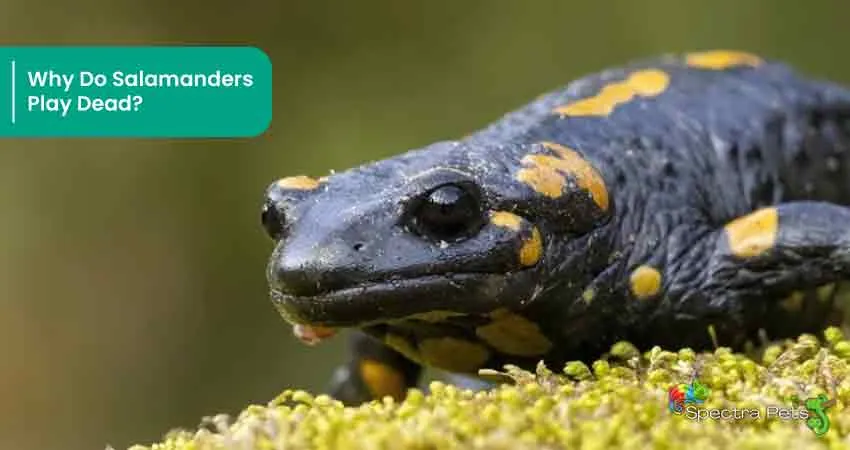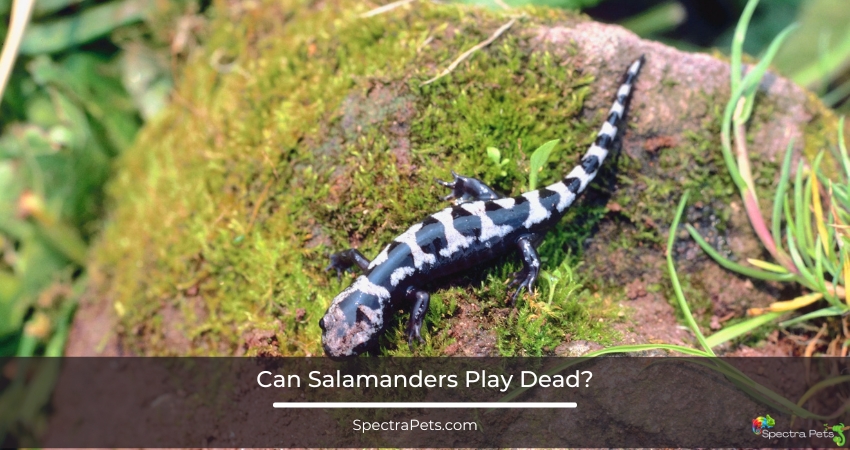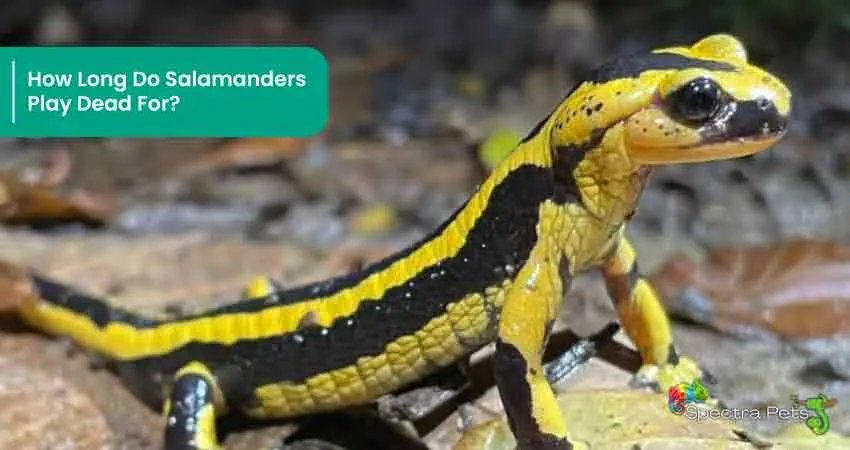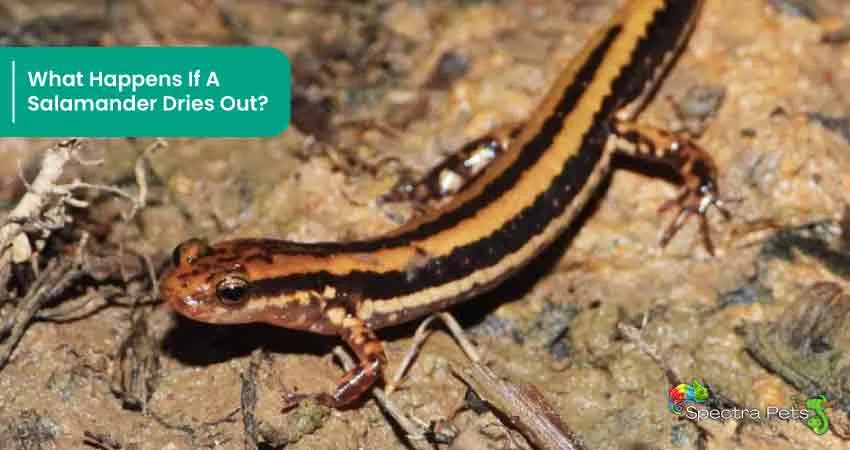There is nothing more horrific than losing a pet we love. But, these naughty cuties tend to traumatize us by pretending that they are dead. Is your salamander capable of such trickery? Good question.
Well, Salamanders are fascinating creatures that have many interesting behaviors, including the ability to play dead. This behavior is also known as “thanatosis” and is typically seen as a defense mechanism in response to a perceived threat.
Now, let’s learn more about this special characteristic of Salamanders so that you can deal with them more carefully.
Why Do Salamanders Play Dead?

Well, the main reason why salamanders show this behavior is to avoid potential predators.
While most salamanders avoid confrontation, some species will use their thanatosis behavior as a way to protect themselves from predators. When threatened, a salamander will typically lie still, sometimes even playing dead, until the threat has passed. This behavior is often accompanied by other defensive tactics, such as puffing up their body or releasing a noxious substance, to make them appear less appetizing.

This behavior is thought to be an evolutionary adaptation that allows salamanders to avoid being eaten by predators. By appearing to be dead, a salamander is less likely to be attacked, giving it time to escape to safety.
However, not all salamanders are able to play dead. This behavior is seen primarily in species that live in open, exposed environments, such as those found in grasslands and forests. Salamanders that live in underground burrows or in water are less likely to use this behavior, as they have other ways of protecting themselves from predators.
While not all salamanders are capable of playing dead, those that are use this behavior as a way to defend themselves against predators. This fascinating adaptation allows them to avoid being eaten, giving them a better chance of survival in the wild.
How Long Do Salamanders Play Dead For?

The length of time that a salamander will play dead for can vary depending on the species and the situation. Some salamanders may only play dead for a few seconds, while others may remain still for several minutes. In general, a salamander will continue to play dead until it perceives that the threat has passed, and it is safe to move again.
One interesting aspect of salamander thanatosis is that it is often a learned behavior. In other words, young salamanders may not initially know how to play dead, but they can learn this behavior from older salamanders in their group. This suggests that thanatosis is not an instinctual behavior, but rather one that is learned and passed down through generations.
How Can You Tell If A Salamander Is Dead?

It can sometimes be difficult to tell if a salamander is dead or just playing dead. Some key signs that a salamander may be dead include:
- Lack of movement: If a salamander is not moving at all and appears to be completely still, it may be dead.
- Lack of response: If you try to gently prod or touch the salamander, and it does not respond in any way, it may be dead.
- Rigid body: If a salamander’s body is stiff and does not move when touched, this could be a sign that it is dead.
- Changes in color: Some salamanders may change color when they die, becoming paler or darker than usual.
It is important to note that these signs can also indicate that a salamander is playing dead, so it is always best to approach with caution and avoid handling them unnecessarily. If you are unsure whether a salamander is dead or just playing dead, it is best to leave it alone and let it be.
Read More: Can Salamander Change Color?
What Do I Do If My Salamander Is Dying?

If you suspect that a salamander is dying, it is important to contact a veterinarian or a qualified expert for advice. They will be able to provide guidance on how to care for the salamander and determine if it needs medical treatment.
In general, it is best to avoid handling salamanders unless necessary, as they are delicate animals that can be easily stressed.
What Happens If A Salamander Dries Out?

Salamanders are amphibians, which means that they need moisture to survive. If a salamander is allowed to dry out, it can become dehydrated and die.
Salamanders have moist, permeable skin that allows them to absorb water and oxygen from their environment. This is why they are typically found in damp, moist environments such as forests, wetlands, and underground burrows. As a salamander’s skin dries out, it becomes dehydrated and is unable to function properly.
As a result, a salamander that has been exposed to dry conditions will become weak and lethargic, and may eventually die. In addition, dehydration can make a salamander more susceptible to illness and infection, which can further reduce its chances of survival.
Therefore, it is important to make sure that salamanders are kept in moist environments and are not allowed to dry out. This will help to ensure their health and well-being and give them the best chance of survival.
Why Do Salamanders Bury Themselves?

Another interesting behavior that these animals show is to bury themselves underground. Let’s find out the exact reason behind this:
Many species of salamanders are burrowing animals and will dig underground tunnels or burrows to live in. This behavior provides them with protection from predators and helps to regulate their body temperature.
One reason why salamanders bury themselves is for protection. Burrowing underground allows them to hide from predators and avoid being seen. This is especially important for salamanders that live in open, exposed environments, such as those found in grasslands and forests. By digging a burrow, a salamander can create a safe and secure place to live where it is less likely to be attacked by predators.
Another reason why salamanders bury themselves is to regulate their body temperature. Salamanders are cold-blooded animals, which means that their body temperature is influenced by their environment.
By burrowing underground, a salamander can create a microclimate that is more stable and consistent, allowing it to maintain a more constant body temperature. This is especially important for salamanders that live in areas with extreme temperatures, such as those found in mountainous regions.
Read More: Do Salamanders Need A Heat Lamp In Captivity?
Wrapping Up
Now that you are familiar with Salamanders’ approach to playing dead, you should be able to tell whether your Salamander is simply fooling you or if it’s truly in trouble. I have also discussed other important matters regarding Salamander behavior, and I am confident that every piece of information I have given you will help you raise your adorable pet in a healthier manner. Happy Salamanding…
